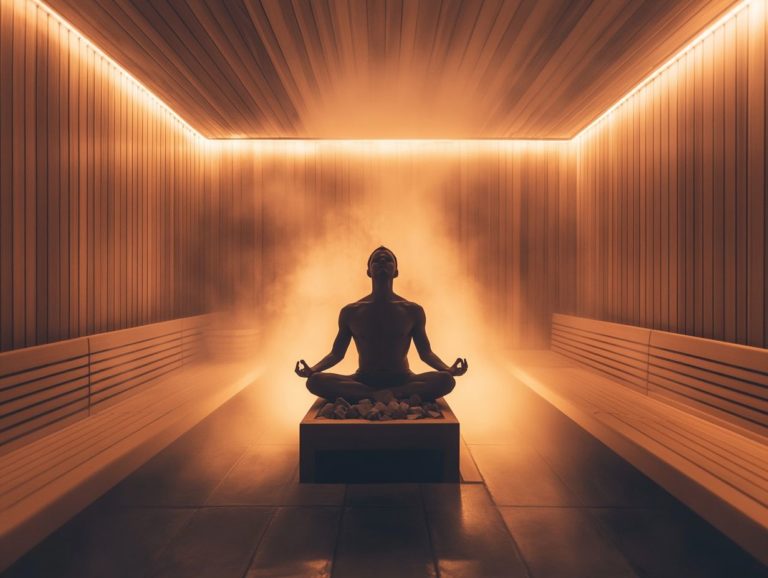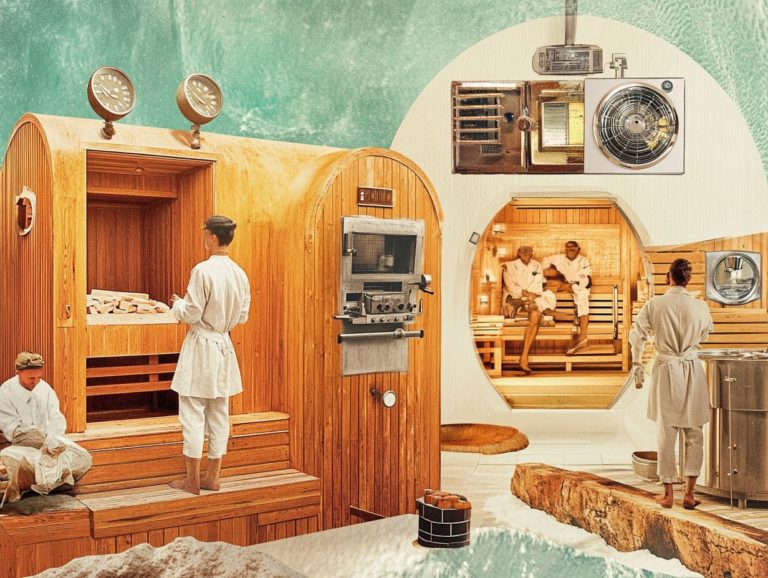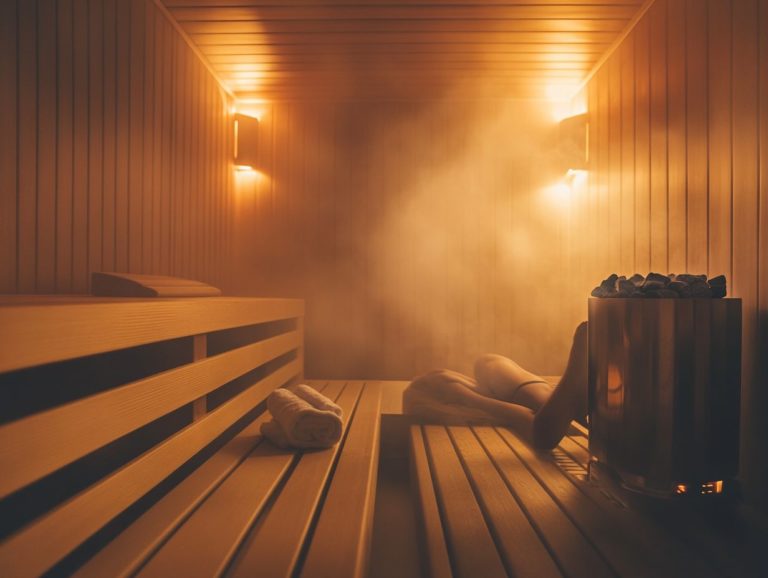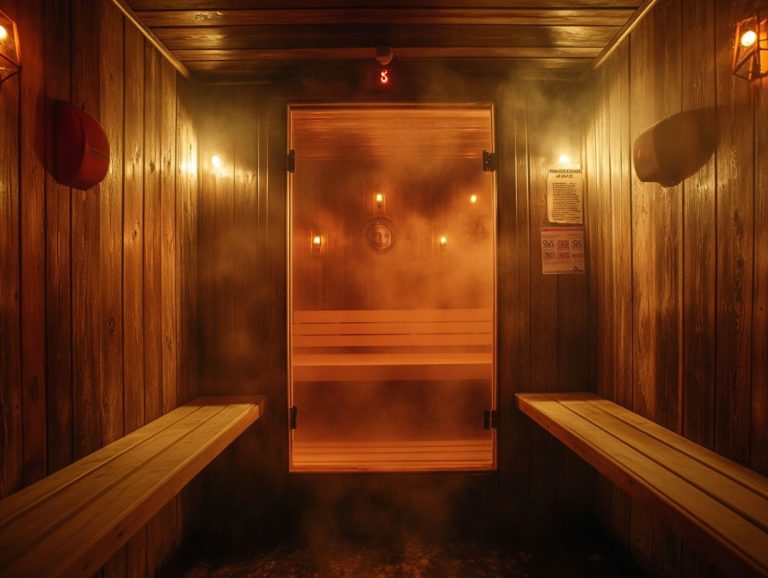Sauna Safety: Guidelines for Family Use
Saunas have long been celebrated for their relaxing and rejuvenating properties. However, it s crucial to enjoy this ancient practice safely.
This article delves into key safety guidelines, particularly focusing on children and the elderly. This ensures that everyone can enjoy the sauna experience without worries.
You will also discover many health benefits from using a sauna. We ll provide you with a step-by-step guide on proper usage and suggest alternatives for those seeking similar advantages.
Get ready to dive into everything you need to know about saunas!
Contents
- Key Takeaways:
- Sauna Safety Guidelines
- Health Benefits of Sauna Use
- How to Properly Use a Sauna
- Alternatives to Sauna Use
- Frequently Asked Questions
- What are the main safety guidelines for using a sauna with your family?
- How can I ensure that my children are safe in a sauna?
- Are there any health conditions that may make using a sauna unsafe?
- What should I do if I feel lightheaded or dizzy while in the sauna?
- Are there any precautions I should take before using a sauna with my family?
- Can children under a certain age safely use a sauna?
Key Takeaways:
- Always supervise children and elderly individuals in the sauna and ensure they follow safety precautions.
- General safety tips for sauna use include staying hydrated, limiting time spent inside, and avoiding alcohol consumption.
- Proper use of the sauna can provide physical and mental health benefits. Alternatives to sauna use include hot baths or showers, steam rooms, and hot yoga.
What is a Sauna?
A sauna is your personal retreat an inviting space designed for relaxation and health benefits. Its roots trace back to Finland, where sauna culture is practically a way of life. You have options: indoor traditional saunas, outdoor escapes, and infrared saunas. Each presents its own unique experiences and advantages for those who appreciate the art of sauna bathing.
Equipped with various accessories like sauna rocks and heaters, these spaces allow you to tailor your sessions. This enhances your relaxation and wellness journey.
Take, for example, the traditional Finnish sauna. Here, wood fuels the heat, and the ritual of pouring water over heated rocks creates a soothing steam. This steam isn t just comforting; it fosters social connections in a communal setting. If you prefer the great outdoors, outdoor saunas provide a tranquil escape, immersing you in nature and grounding your experience.
Conversely, infrared saunas employ advanced technology to penetrate the skin more deeply, enhancing detoxification benefits the process of removing toxins from the body. Across cultures, from the Russian banya to the Japanese sento, saunas have been celebrated for their therapeutic effects. These effects include improved circulation, detoxification, and stress relief.
These sessions can be further enhanced with accessories like essential oils, elevating the soothing atmosphere and transforming each visit into a unique wellness journey.
Sauna Safety Guidelines
Ensuring sauna safety is crucial for you and all users, especially if you have health conditions like high blood pressure or heart issues. Vulnerable groups, such as children and pregnant women, should definitely consult with a physician before using a sauna.
By adhering to thorough sauna safety guidelines like proper supervision and childproofing the area, you can create a safe sauna environment. Following sauna temperature guidelines for safety not only enhances your overall experience but also minimizes potential risks.
Precautions for Children and Elderly
When using a sauna, it s crucial to take specific precautions to ensure the safety of children and elderly family members. They are often more susceptible to overheating and dehydration. Establishing supervision and implementing effective childproofing measures are essential steps to prevent accidents.
You should monitor their sauna time closely, limiting sessions to shorter durations typically around 5 to 10 minutes depending on their comfort level. Keeping water readily available encourages proper hydration, helping to counteract any potential fluid loss. Additionally, understanding the role of heat in sauna safety is crucial for a safe experience.
It s also wise to adjust the sauna temperature to a moderate setting, usually not exceeding 150 F. This creates a comfortable atmosphere for sensitive users. Regular check-ins during their sauna time can significantly enhance safety, allowing for timely interventions if any signs of discomfort arise.
These tailored safety measures ensure that everyone can enjoy the benefits of sauna use without unnecessary risks.
Ready to start your sauna journey? Follow these guidelines and enjoy your time!
General Safety Tips
General safety tips are essential for ensuring an enjoyable sauna experience. Start by maintaining proper hydration and adhering to sauna etiquette, which highlights the importance of respecting the shared space with others. Monitor the sauna temperature and set a timer. You want to heat your body, not turn the entire room into a sauna inferno.
To achieve the best results while minimizing risks, consider limiting your sauna sessions to 15-20 minutes. This way, both your body and mind can enjoy the benefits without overdoing it. After your session, cooling down is equally important. Engage in gentle stretching or take a lukewarm shower to help your body adjust.
It s wise to skip alcohol before or during your sauna time, as it can lead to dehydration and cloud your judgment. By following these practical guidelines, you can elevate your sauna experience into a restorative and safe ritual.
Health Benefits of Sauna Use
The health benefits of sauna use are remarkable, offering a wealth of both physical and mental enhancements that make sauna therapy a favored option among health enthusiasts. Engaging in regular sauna sessions can foster relaxation, boost circulation, alleviate muscle tension, and even contribute to cardiovascular health.
It s crucial to prioritize rehydration after your sauna session. Seek expert advice on safe sauna practices to ensure you fully reap the rewards.
Physical and Mental Benefits
Sauna therapy presents a wealth of physical and mental benefits, making it a cherished practice for those seeking relaxation and rejuvenation. On the physical side, saunas can help recover muscles, improve joint mobility, and enhance cardiovascular function. Mentally, they offer a peaceful escape that alleviates stress and fosters mental clarity.
Research shows that the elevated temperatures during sauna sessions can increase your heart rate, much like moderate exercise. This boost in circulation can help lower blood pressure over time.
Regular sauna use can enhance your sleep quality and bolster your resilience to stress, leading to a more positive mental state. A study published in the Journal of Human Hypertension found a correlation between frequent sauna use and a reduced risk of cardiovascular diseases. Research in Psychosomatic Medicine showed significant reductions in anxiety and depression among participants.
This holistic approach to health is why countless enthusiasts eagerly look forward to their sauna sessions each week!
How to Properly Use a Sauna
To truly savor the sauna experience, it s essential to adhere to proper guidelines and etiquette. This not only ensures your safety but also respects the experience of fellow sauna enthusiasts.
- Whether you re indulging in an indoor traditional sauna, basking in an outdoor retreat, or enjoying the benefits of an infrared sauna knowing how to operate a sauna timer effectively is key.
- Maintain cleanliness through diligent cleaning.
- Follow general etiquette to elevate your overall enjoyment.
Step-by-Step Guide
A step-by-step guide to using a sauna effectively reveals key practices that ensure a safe and enjoyable experience. Start by setting the ideal sauna temperature and utilizing a timer to manage your sessions. It’s crucial to maintain proper hydration before, during, and after your sauna time to prevent dehydration and fully reap the health benefits of this practice.
Before stepping into the sauna, take a shower to cleanse your skin, enhancing the sweating process. Wear loose-fitting clothing or wrap yourself in a towel to allow your body to breathe and help regulate temperature comfortably.
As you enter the sauna, start with shorter sessions to let your body acclimate to the heat, gradually extending the duration as you grow more comfortable. During your time inside, consider using a sauna bucket for moisture or placing damp towels on the benches to create a calming atmosphere.
Always pay attention to how you feel. If you start to feel lightheaded or dizzy, exit the sauna immediately and hydrate.
After leaving the sauna, allow your body to cool down gradually. Remember to continue drinking plenty of fluids to support your overall well-being.
Ready to experience the benefits of sauna therapy? Book your next sauna session today!
Alternatives to Sauna Use
If you find yourself unable to enjoy a sauna, whether because of health concerns or personal choice, there are several alternatives that can deliver similar relaxation and wellness benefits.
Imagine sinking into a hot bath, uniting with steam rooms, or utilizing infrared heating pads. Each of these options captures some of the essence of sauna therapy, allowing you to experience soothing relief and enhanced well-being.
Other Ways to Achieve Similar Benefits
Various relaxation techniques can serve as excellent alternatives to sauna use, allowing you to enjoy similar wellness benefits in your own unique way. Hot baths, steam rooms, and infrared heating pads each offer effective methods to help you relax, enhance circulation, and provide much-needed stress relief.
Practicing yoga can further elevate your well-being. It reduces anxiety and fosters mental clarity. Engaging in mindful meditation also contributes to a calm mind. Each alternative method brings its own set of advantages: hot baths envelop you in soothing warmth and relieve muscle tension, while steam rooms offer a humid heat that opens up your airways.
Infrared heating pads penetrate deeper layers of skin, delivering targeted heat that can be particularly beneficial for chronic pain relief. Remember, safety and effectiveness can vary among these options. It s essential to consider your personal health conditions and preferences when selecting the best approach for stress relief and overall health enhancement.
Frequently Asked Questions
-
What are the main safety guidelines for using a sauna with your family?
Always keep safety in mind limit your sauna time to 15-20 minutes, stay hydrated, and do not exceed the recommended temperature of 170-190 degrees Fahrenheit.
-
How can I ensure that my children are safe in a sauna?
To ensure the safety of children in a sauna, closely supervise them at all times. Limit their sessions to 5-10 minutes, and make sure they understand the potential dangers of high heat.
-
Are there any health conditions that may make using a sauna unsafe?
Yes, individuals with certain health conditions such as low blood pressure, heart disease, or pregnancy should talk to their doctor first before using a sauna. It s always important to prioritize safety and listen to your body.
-
What should I do if I feel lightheaded or dizzy while in the sauna?
If you start to feel lightheaded or dizzy while in the sauna, exit immediately and cool down. Drink plenty of water and consider taking a break before returning to the sauna.
-
Are there any precautions I should take before using a sauna with my family?
Before using a sauna with your family, ensure everyone is well-hydrated and properly dressed in loose, breathable clothing. It s also recommended to shower before entering the sauna to remove any lotions or oils that may hinder sweating.
-
Can children under a certain age safely use a sauna?
Children under the age of 6 should not use a sauna, as their bodies are not yet fully equipped to regulate high temperatures. For children ages 6-12, limit sauna sessions to 5-10 minutes and supervise them closely. Consult with a doctor if you have any concerns.
Explore these alternatives today for a healthier, happier you!






